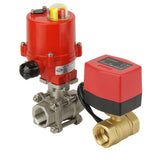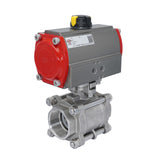Collection:Ball Valves
Ball Valves

Explore Tameson's wide range of ball valves from various global manufacturers. A ball valve is a type of shutoff valve used to control the flow of a medium (liquid or gas) by using a rotating ball with a bore. They are one of the most common valves due to their simple operation, reliability, long service life, and wide range of applications. Ball valves can be operated manually or with the help of an electric or pneumatic actuator for remote automated operations.
You can select the proper ball valve type depending on the application and available electrical/pneumatic input. Most commonly, ball valves can be 2-way or 3-way. 2-way ball valves have 2 ports: an inlet and an outlet. The media flows from one direction to the other, and the valve is used to open or close the flow. A 2-way ball valve is commonly called a shut-off valve. 3-way ball valves have three ports. The bore in the ball is not straight but rather in an L or T formation. This allows for various circuit functions for the valve. It can be used to distribute, mix, or divert flow in the desired direction. Therefore, any of the three ports can be an inlet or an outlet.
The most common housing materials for ball valves are stainless steel, brass, and PVC. There are special ball valve types like true union, vented (to depressurize systems), flanged (for easy installation), and hydraulic (for high-pressure applications), and ball valves with approvals for gas, oxygen, and drinking water. Also, there are ball valves that come without a handle or actuator but are suitable for use with actuators (electrical or pneumatic) with standard flanges adhering to ISO standards like ISO 5211. This allows a user to swap either the actuator or the valve out in an application due to the standardized flange.






